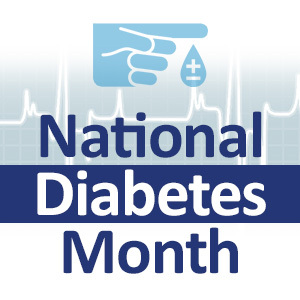
November is National Diabetes Month. Diabetes is a series of conditions where an individual has abnormally high blood sugar levels over a period of time. There are three main types of diabetes:
Type 1 Diabetes
Commonly referred to as type 1 diabetes, this type is often diagnosed in young adults and children. With type 1 diabetes, the body does not produce enough insulin, a chemical that helps to break down starches, sugar and other food into energy (glucose) that the body can use.
Individuals living with type 1 diabetes must monitor their blood sugar levels and inject themselves with insulin as needed. An estimated 5% of diabetic people have type 1 and the cause is unknown.
Type 2 Diabetes
This is the most common type of diabetes. Middle-aged and older adults are at the highest risk. With type 2 diabetes, the body may not produce enough insulin, or cells do not respond properly to the insulin. Left untreated, this causes glucose to build up in the blood, potentially starving cells and eventually causing serious conditions such as damage to the eyes, kidneys, nerves and heart.
Ideally, those with type 2 diabetes will carefully watch their diets, maintain a healthy weight, regularly engage in physical activity and take medicine to manage their blood sugar levels.
In most cases, before developing type 2 diabetes, people have prediabetes. This means that blood sugar levels are elevated but not high enough for diabetes. The symptoms of prediabetes are often nonexistent, so getting tested for diabetes is usually how most people find out.
Having prediabetes puts you at higher risk for type 2 diabetes, so in this case, it’s important to get checked for type 2 diabetes every year. Early treatment of prediabetes could reduce blood sugar levels back to a normal range.
Gestational Diabetes
This type of diabetes occurs at about 6 months into a pregnancy. It does not mean that diabetes was present before pregnancy or will be after giving birth, but managing blood sugar levels with gestational diabetes is just as important as it is for any other type of diabetes, especially for the health of the baby.
According to a CDC analysis, the prevalence of gestational diabetes in the US is as high as 9.2% (among pregnant women). Those affected are more than seven times more likely to develop type 2 diabetes within 10 years after having their child.
Preventing Diabetes
Fortunately, there are several simple ways to help prevent type 2 diabetes. These healthy practices can also lower the likelihood of developing heart disease and some cancers.
- Staying active: Those who are physically active less than 3 times a week are at increased risk for type 2 diabetes. Exercising improves your muscles’ ability to use insulin, putting less stress on the cells that create it. Even a half-hour of fast walking every day could reduce the risk of type 2 diabetes by nearly a third.
- Quit smoking. Smokers are at least 50% more likely to get diabetes.
- Watch your diet and control your weight: Being overweight or obese is one of the main causes of type 2 diabetes, raising the risk by seven to thirty times.
- These are some of the ways in which you can change your diet and watch your weight to reduce your risk:
- Reduce calorie and trans fat intake.
- Opt for water, coffee or tea instead of sugary drinks.
- Limit your intake of processed and red meat. Instead choose poultry or fish.
- Keep a record of your weight, what you ate, and your physical activity.
- Make reasonable goals to lose weight. Sometimes losing only 10-15 pounds can greatly decrease your risk for diabetes.
- Enjoy a drink once in a while. Limited alcohol consumption is being proven to reduce the risk of heart disease and type 2 diabetes. As always, however, moderation is key, and it is recommended that women have no more than 1 drink per day, and men have no more than 2 drinks per day.
- The American Diabetes Association has additional guidelines you should consider before drinking alcohol for its health benefits. If you do not drink, the same benefits can be achieved by following the other recommendations above.
Diabetes affects nearly 10% of the US population, and more than a quarter of those cases are undiagnosed. Every year, about 1.8 million new cases are diagnosed.
Those with diabetes should get an A1C test twice a year. This test shows average blood sugar levels of the past 2-3 months. In addition, blood pressure should be checked at every checkup and blood fats should be checked at least once a year.
